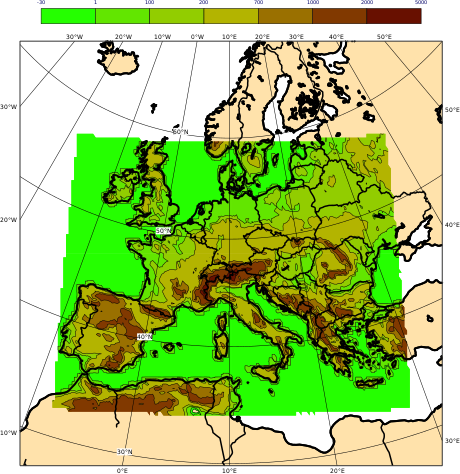
Last updated: 22 Sep 2020
COSMO-LEPS is the Limited Area Ensemble Prediciton System developed within COSMO consortium in order to improve the short-to-medium range forecast of extreme and localised weather events. It is made up of 20 integrations of COSMO model, which is nested on selected members of ECMWF ENS.
COSMO-LEPS started to run on an experimental-operatonal basis on November 2002 and, in November 2005, it became an ECMWF member-state time-critical application, managed remotely by Arpae-SIMC.
COSMO-LEPS runs twice a day, starting at 00 and 12UTC, using a 7 km grid spacing and 40 vertical layers, with a forecast range of 132 hours. The computer time to run the system at ECMWF is provided by a joint account, with the contributions of the COSMO countries which are also ECMWF member state (namely, Greece, Germany, Italy and Switzerland).
The rotated lat-lon coordinates of the lower left and upper right corner of the integration domain are lon=-15.75, lat=-16.125 and lon=16.125, lat=9.75, respectively. The coordinates of the Southern pole of rotation are: latitude=-40N, longitude=10E.
The orography (height in m) of the COSMO-LEPS integration domain.

COSMO-LEPS was born as a dynamical downscaling of the IFS-ENS of ECMWF. The LEPS methodology was developed at Arpae-SIMC by performing a Cluster Analysis of the members of the IFS-ENS, in order to select the "most representative members" of the global ensemble to drive few Limited-Area integrations of a regional model (Molteni et al., 2001; Marsigli et al., 2001).
Currently, a "super-ensemble" of 102 members, made of two successive runs of IFS-ENS, is clustreized with the Cluster Analysis algorithm, in order to select the 20 members on which to nest 20 runs of the COSMO model.
The model physics is also perturbed, with Parameter Perturbation. A set of parameters of the physics schemes of the COSMO model is perturbed in the model runs, by assiging them values different from the default value. The perturbation is kept fixed during the model intergration. The parameters and their range of variability have been selected with a sensitivity study (Marsigli et al., 2009 and 2013).
The current version of COSMO-LEPS is described in Montani et al., 2011.
COSMO-LEPS increases the ensemble size from 16 to 20 members run in Single Precision; no SPPT by now for stability problems.
COSMO-EU fields are no more used: ICON-EU data are used instead.
No more use of IFS-Bechtold convection scheme; all members use Tiedtke scheme.
No more use of Kain-Fritsch scheme (which is no more maintained); members 1-8 use Tiedtke convection scheme, members 9-16 use IFS-Bechtold convection scheme.
COSMO-LEPS doubles; it is run at both 00 and 12UTC.
introduction of (randomly chosen) perturbed parameters in COSMO-LEPS runs
COSMO-LEPS products are archived every 3 hours
the LM-det run is also produced; it is a further run of COSMO nested on the high-resolution deterministic forecast of ECMWF in the same configuration as COSMO-LEPS integrations (10 km, 32 ml, 120h range).
As for the 00UTC (12UTC) run, COSMO-LEPS application starts at about 07.30UTC (19.30UTC), once the ECMWF ENS has passed fc+144h forecast range. Products are disseminated to Met Ops rooms of COSMO weather offices starting from about 08.30UTC (20.30UTC).
| Suite | int2lm | cosmo |
|---|---|---|
| Forecast | namelists |
Marsigli C., Montani A., Nerozzi F., Paccagnella T., Tibaldi S., Molteni F. and Buizza R., 2001. “A strategy for high-resolution ensemble prediction. II: Limited-area experiments in four Alpine flood events.” Quarterly Journal of the Royal Meteorol. Soc., 127, 2095-2115.
Marsigli C., 2009: "Final report on priority project SREPS (Short Range Ensemble Prediction System)". COSMO Technical Report No. 13. DOI: DOI: 10.5676/DWDpub/nwv/cosmo-tr13
Marsigli C., T. Diomede, A. Montani, T. Paccagnella, P. Louka, F. Gofa and A. Corigliano, 2013: " The CONSENS Priority Project ". COSMO Technical Report No. 13. DOI: DOI: 10.5676/DWDpub/nwv/cosmo-tr22
Molteni F., Buizza R., Marsigli C., Montani A., Nerozzi F. and Paccagnella T., 2001. “A strategy for high-resolution ensemble prediction. I: Definition of representative members and global-model experiments.” Quarterly Journal of the Royal Meteorol. Soc., 127, 2069-2094.
Montani, A., M. Capaldo, D. Cesari, C. Marsigli, U. Modigliani, F. Nerozzi, T. Paccagnella, P. Patruno and S. Tibaldi, 2003: Operational limited–area ensemble forecasts based on the Lokal Modell. ECMWF Newsletter 98, 2–7. Available at: http://www.ecmwf.int/publications/.
Montani A., Cesari D., Marsigli C. and Paccagnella T., 2011. “Seven years of activity in the field of mesoscale ensemble forecasting by the COSMO-LEPS system: main achievements and open challenges.” Tellus A, 63A, 605-624.